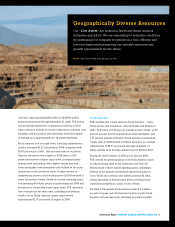Freeport-McMoRan 2008 Annual Report Download - page 21
Download and view the complete annual report
Please find page 21 of the 2008 Freeport-McMoRan annual report below. You can navigate through the pages in the report by either clicking on the pages listed below, or by using the keyword search tool below to find specific information within the annual report.
Management’s Discussion and Analysis
2008 Annual Report FREEPORT-McMoRan COPPER & GOLD INC. 19
average prices of $1.50 per pound of copper, $800 per ounce
of gold and $9.00 per pound of molybdenum in 2009, our
consolidated operating cash flows would approximate $1.0 billion
in 2009, which is net of an estimated $0.6 billion for working
capital requirements. Working capital requirements for 2009
principally reflect the impact of the declines in copper prices
during fourth-quarter 2008 and resulting settlements with
customers on 2008 provisionally priced sales. Operating cash
flows for 2009 would be impacted by approximately $260 million
for each $0.10 per pound change in copper prices, $60 million
for each $50 per ounce change in gold prices and $50 million for
each $1 per pound change in molybdenum prices.
Assuming average prices of $1.50 per pound of copper, $800
per ounce of gold and $9.00 per pound of molybdenum for 2009,
we estimate our consolidated unit net cash costs related to our
copper mining operations (after by-product credits) will average
approximately $0.71 per pound in 2009, which is lower than
consolidated unit net cash costs of $1.16 per pound in 2008 (refer
to “Consolidated Results – Production and Delivery Costs”
for further discussion). Lower estimated consolidated unit net
cash costs in 2009 primarily reflect the effects of reduced
energy prices and other commodity-based input costs and lower
operating rates. Consolidated unit net cash costs would be
impacted by $0.025 per pound for each $50 per ounce change in
gold prices and $0.01 per pound for each $1 per pound change
in molybdenum prices.
COPPER, GOLD AND MOLYBDENUM MARKETS
The graphs below illustrate the movements in metals prices from
January 1992 through January 2009. World prices for copper, gold
and molybdenum have fluctuated significantly during this period.
The LME spot copper price varied from a low of $0.60 per pound
in 2001 to a high of $4.08 per pound in July 2008, the London
gold price fluctuated from a low of approximately $250 per ounce
in 1999 to a high of $1,011 per ounce in March 2008, and the
Metals Week Molybdenum Dealer Oxide price ranged from a low
of $1.82 per pound in 1992 to a high of $40.00 per pound in 2005.
Copper, gold and molybdenum prices are affected by numerous
factors beyond our control as described further in our “Risk
Factors” contained in Part I, Item 1A of our Form 10-K for the year
ended December 31, 2008.
Historical LME Copper Prices
Through January 30, 2009
* Excludes Shanghai stocks, producer, consumer and merchant stocks.
The graph above presents LME spot copper prices and reported
stocks of copper at the LME and the New York Mercantile
Exchange (COMEX) from January 1992 through January 2009.
During the period 2003 to 2006, global consumption exceeded
production, evidenced by the decline in exchange warehouse
inventories. Disruptions associated with strikes and other
operational issues, combined with growing demand from China
and other emerging economies resulted in low levels of inventory
from 2006 through most of 2008. However, slowing consumption
has led to increases in inventory levels in recent months, with
combined LME and COMEX stocks rising to approximately 370
thousand metric tons at December 31, 2008, compared to
approximately 208 thousand metric tons at September 30, 2008.
Combined LME and COMEX stocks have increased further to
approximately 530 thousand metric tons at January 30, 2009.
Turmoil in the United States (U.S.) financial markets and
concerns about the global economy have negatively impacted
copper prices in recent months. After averaging $3.05 per pound
in 2006, $3.23 per pound in 2007 and $3.61 per pound for the
first nine months of 2008, LME spot copper prices declined to a
four-year low of $1.26 per pound in December 2008. For the year
2008, LME spot copper prices ranged from $1.26 per pound to
$4.08 per pound, averaged $3.15 per pound and closed at $1.32
per pound on December 31, 2008. While the near-term outlook is
weak and uncertain, we believe the underlying fundamentals of
the copper business remain positive, supported by supply side
constraints and the absence of significant new development
projects. Future copper prices may continue to be volatile and are
expected to be influenced by demand from China, economic
activity in the U.S. and other industrialized countries, the timing
of the development of new supplies of copper and production
levels of mines and copper smelters. The LME spot copper price
closed at $1.41 per pound on January 30, 2009.
92 0094
LME Copper Prices
LME & COMEX Exchange Stocks*
0296 04 0698 08
dollars per pound
000s of metric tons
300
600
900
1,200
1,500
$1.50
$3.00
$3.50
$4.00
$2.50
$2.00
$1.00
$0.50
$4.50
























